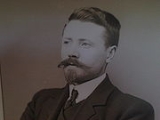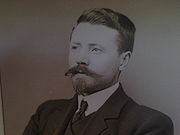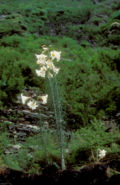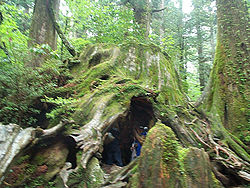
Ernest Henry Wilson
Encyclopedia

Western culture
Western culture, sometimes equated with Western civilization or European civilization, refers to cultures of European origin and is used very broadly to refer to a heritage of social norms, ethical values, traditional customs, religious beliefs, political systems, and specific artifacts and...
; some sixty bear his name.
Career
Wilson was born in Chipping CampdenChipping Campden
Chipping Campden is a small market town within the Cotswold district of Gloucestershire, England. It is notable for its elegant terraced High Street, dating from the 14th century to the 17th century...
, Gloucestershire
Gloucestershire
Gloucestershire is a county in South West England. The county comprises part of the Cotswold Hills, part of the flat fertile valley of the River Severn, and the entire Forest of Dean....
but the family soon moved to Shirley, Warwickshire, where they set up a floristry business. He left school early for employment at the local nursery of Messrs. Hewitt, Warwickshire, as apprentice gardener, and, aged 16, at the Birmingham Botanical Gardens
Birmingham Botanical Gardens
The Birmingham Botanical Gardens are botanical gardens situated in Edgbaston, Birmingham, England. The gardens are close to the centre of Birmingham and open every day of the year, from sunrise to sunset. They are located at ....
; there he also studied at Birmingham Technical School in the evenings, receiving the Queen's Prize for botany. In 1897 he began work at the Royal Botanic Gardens, Kew
Royal Botanic Gardens, Kew
The Royal Botanic Gardens, Kew, usually referred to as Kew Gardens, is 121 hectares of gardens and botanical glasshouses between Richmond and Kew in southwest London, England. "The Royal Botanic Gardens, Kew" and the brand name "Kew" are also used as umbrella terms for the institution that runs...
, where he won the Hooker Prize
Joseph Dalton Hooker
Sir Joseph Dalton Hooker OM, GCSI, CB, MD, FRS was one of the greatest British botanists and explorers of the 19th century. Hooker was a founder of geographical botany, and Charles Darwin's closest friend...
for an essay on conifers. He then accepted a position as Chinese plant collector with the firm of James Veitch & Sons
Veitch Nurseries
The Veitch Nurseries were the largest group of family-run plant nurseries in Europe during the 19th century. Started by John Veitch sometime before 1808, the original nursery grew substantially over several decades and was eventually split into two separate businesses - based at Chelsea and...
, who were eager above all to retrieve the dove tree, Davidia involucrata. "Stick to the one thing you are after," advised Harry Veitch
Harry Veitch
Sir Harry James Veitch was an eminent English horticulturist in the nineteenth century, who was the head of the family nursery business, James Veitch & Sons, based in Chelsea, London...
, who had more than a dozen plant hunters on payroll, "and don't spend time and money wandering about. Probably every worthwhile plant in China has now been introduced to Europe."
After six months at Veitch's Coombe Woods Nursery, Wilson travelled west towards China
China
Chinese civilization may refer to:* China for more general discussion of the country.* Chinese culture* Greater China, the transnational community of ethnic Chinese.* History of China* Sinosphere, the area historically affected by Chinese culture...
, stopping for five days at the Arnold Arboretum in Boston
Boston
Boston is the capital of and largest city in Massachusetts, and is one of the oldest cities in the United States. The largest city in New England, Boston is regarded as the unofficial "Capital of New England" for its economic and cultural impact on the entire New England region. The city proper had...
, Massachusetts
Massachusetts
The Commonwealth of Massachusetts is a state in the New England region of the northeastern United States of America. It is bordered by Rhode Island and Connecticut to the south, New York to the west, and Vermont and New Hampshire to the north; at its east lies the Atlantic Ocean. As of the 2010...
, where he carried a letter of introduction to Charles Sprague Sargent
Charles Sprague Sargent
Charles Sprague Sargent was an American botanist. He was the first director of the Arnold Arboretum at Harvard University in Boston, Massachusetts and the standard botanical author abbreviation Sarg. is applied to plants he described.-Biography:Sargent was the second son of Henrietta and...
and studied techniques for shipping seeds and plants without damage. He continued across the U.S. by train, and sailed from San Francisco, reaching Hong Kong
Hong Kong
Hong Kong is one of two Special Administrative Regions of the People's Republic of China , the other being Macau. A city-state situated on China's south coast and enclosed by the Pearl River Delta and South China Sea, it is renowned for its expansive skyline and deep natural harbour...
on 3 June 1899. Sargent had suggested he head straight to Sze-mao to talk to Augustine Henry
Augustine Henry
Augustine Henry was an Irish plantsman and sinologist. He is best known for sending over 15,000 dry specimens and seeds and 500 plant samples to Kew Gardens in the United Kingdom. By 1930, he was a recognised authority and was honoured with society membership in Belgium, Czechoslovakia, Finland,...
, who had seen a unique dove tree twelve years previously. Though the tree had been recently cut down when Wilson reached it, he rediscovered the specimens noticed by Père David 600 km away in Ichang, Hubei. Wilson collected for two years in Hubei Province, reaching isolated mountain valleys with an intrepid spirit that has made him legendary, before returning to England in April 1902 with seed of 305 species, and 35 Wardian case
Wardian case
The Wardian case, was an early type of sealed protective container for plants, which found great use in the 19th Century in protecting foreign plants imported to Europe from overseas, the great majority of which had previously died from exposure during long sea journeys, frustrating the many...
s of bulb
Bulb
A bulb is a short stem with fleshy leaves or leaf bases. The leaves often function as food storage organs during dormancy.A bulb's leaf bases, known as scales, generally do not support leaves, but contain food reserves to enable the plant to survive adverse conditions. At the center of the bulb is...
s, corm
Corm
A corm is a short, vertical, swollen underground plant stem that serves as a storage organ used by some plants to survive winter or other adverse conditions such as summer drought and heat ....
s, rhizome
Rhizome
In botany and dendrology, a rhizome is a characteristically horizontal stem of a plant that is usually found underground, often sending out roots and shoots from its nodes...
s, and tuber
Tuber
Tubers are various types of modified plant structures that are enlarged to store nutrients. They are used by plants to survive the winter or dry months and provide energy and nutrients for regrowth during the next growing season and they are a means of asexual reproduction...
s, many of which Veitch introduced into Western commerce, as well as dried herbarium
Herbarium
In botany, a herbarium – sometimes known by the Anglicized term herbar – is a collection of preserved plant specimens. These specimens may be whole plants or plant parts: these will usually be in a dried form, mounted on a sheet, but depending upon the material may also be kept in...
specimens, representing some 906 plant species
Species
In biology, a species is one of the basic units of biological classification and a taxonomic rank. A species is often defined as a group of organisms capable of interbreeding and producing fertile offspring. While in many cases this definition is adequate, more precise or differing measures are...
.

Edgbaston
Edgbaston is an area in the city of Birmingham in England. It is also a formal district, managed by its own district committee. The constituency includes the smaller Edgbaston ward and the wards of Bartley Green, Harborne and Quinton....
, but within six months Veitch sent him out again, this time with the yellow Chinese poppy, Meconopsis integrifolia
Meconopsis
Meconopsis is a genus of flowering plants in the family Papaveraceae. The species have attractive flowers and have two distinct ranges. A single species, Meconopsis cambrica , is indigenous to England, Wales, Ireland, and the fringes of Western Europe. The other 40 or so species are found in the...
as his objective. In 1903 Wilson discovered the Regal lily in west Szechuan along the Min River. He revisited the site in 1908 and collected more bulbs, but most of these rotted while en route back to the Arnold Arboretum in Boston. In 1910 he again returned to the Min valley, but this time his leg was crushed during an avalanche of boulders as he was carried along the trail in his sedan chair. After setting his leg with the tripod of his camera, he was carried back to civilization on a three-day forced march. Thereafter he walked with what he called his "lily limp". It was this third shipment of bulbs that successfully introduced the Regal Lily into cultivation in the United States.
A few of the many plants introduced to western cultivation from his first expedition include Acer
Maple
Acer is a genus of trees or shrubs commonly known as maple.Maples are variously classified in a family of their own, the Aceraceae, or together with the Hippocastanaceae included in the family Sapindaceae. Modern classifications, including the Angiosperm Phylogeny Group system, favour inclusion in...
griseum, Actinidia
Actinidia
Actinidia is a genus of woody and, with few exceptions, dioecious plants native to temperate eastern Asia, occurring throughout most of China, Taiwan, Korea and Japan, and extending north to southeast Siberia and south into Indochina...
deliciosa (kiwi fruit), Berberis
Berberis
Berberis , the barberries or pepperidge bushes, is a genus of about 450-500 species of deciduous and evergreen shrubs from 1-5 m tall with thorny shoots, native to the temperate and subtropical regions of Europe, Asia, Africa, North America and South America. They are closely related to the genus...
julianae, Clematis
Clematis
Clematis is a genus of about 300 species within the buttercup family Ranunculaceae. Their garden hybrids have been popular among gardeners beginning with Clematis × jackmanii, a garden standby since 1862; more hybrid cultivars are being produced constantly. They are mainly of Chinese and Japanese...
armandii, Clematis
Clematis
Clematis is a genus of about 300 species within the buttercup family Ranunculaceae. Their garden hybrids have been popular among gardeners beginning with Clematis × jackmanii, a garden standby since 1862; more hybrid cultivars are being produced constantly. They are mainly of Chinese and Japanese...
montana var. rubens, Davidia involucrata, Ilex pernyi, Jasminum mesnyi, and Primula
Primula
Primula is a genus of 400–500 species of low-growing herbs in the family Primulaceae. They include primrose, auricula, cowslip and oxlip. Many species are grown for their ornamental flowers...
pulverulenta. Many of the species he collected were formally named by Maxwell T. Masters
Maxwell T. Masters
Maxwell Tylden Masters was an English botanist and taxonomist. He was educated at King's College London and the University of St Andrews...
. In his reminiscence If I were to Make a Garden, Wilson claimed to have introduced 25 species of wild rose to the West. One of them, Rosa willmottiae
Rosa willmottiae
Rosa willmottiae is a species in the genus Rosa in the plant family Rosaceae. It grows at an altitude of in dry valleys in western Sichuan, China. It forms an arching deciduous shrub high, and as much across. The branches are covered in many straight prickles. The pinnate leaves typically have 7...
was named after Ellen Willmott
Ellen Willmott
Ellen Ann Willmott was an English horticulturalist. She was an influential member of the Royal Horticultural Society, and a recipient of the first Victoria Medal of Honour in 1897. She cultivated more than 100,000 species of plants, and sponsored expeditions to discover new species...
a famous, important sponsor, expert and writer of "The Genus Rosa". Early in the 20th century Henry Morris Upcher, owner of Sheringham Park
Sheringham Park
Sheringham Park is a landscape park and gardens near the town of Sheringham, Norfolk, England. The park surrounds Sheringham Hall and has a grid reference of . The Hall is privately occupied, but Sheringham Park is in the care of the National Trust and open to visitors.The park was designed by...
, Norfolk
Norfolk
Norfolk is a low-lying county in the East of England. It has borders with Lincolnshire to the west, Cambridgeshire to the west and southwest and Suffolk to the south. Its northern and eastern boundaries are the North Sea coast and to the north-west the county is bordered by The Wash. The county...
, England
England
England is a country that is part of the United Kingdom. It shares land borders with Scotland to the north and Wales to the west; the Irish Sea is to the north west, the Celtic Sea to the south west, with the North Sea to the east and the English Channel to the south separating it from continental...
obtained Rhododendron
Rhododendron
Rhododendron is a genus of over 1 000 species of woody plants in the heath family, most with showy flowers...
seeds of various types from Wilson. Plants from this source which can found at the garden include Rhododendron ambiguum, calophytum and decorum, among others.

Japan
Japan is an island nation in East Asia. Located in the Pacific Ocean, it lies to the east of the Sea of Japan, China, North Korea, South Korea and Russia, stretching from the Sea of Okhotsk in the north to the East China Sea and Taiwan in the south...
(1911-1916), where he collected 63 named forms of cherry blossom. One of his footprints in Japan is Wilson's introduction of the gigantic "Yaku
Yakushima
, one of the Ōsumi Islands, is an island of about 500 km² and roughly 15,000 islanders to the south of Kyūshū in Kagoshima Prefecture, Japan. The Vincennes Strait separates it from Tanegashima. The highest point on the island is Miyanoura-dake at 1,935 metres...
sugi stump
Tree stump
After a tree has been cut and felled, the stump or tree stump is usually a small remaining portion of the trunk with the roots still in the ground. Stumps may show the age-defining rings of a tree. The study of these rings is known as dendrochronology....
" called in Yakushima
Yakushima
, one of the Ōsumi Islands, is an island of about 500 km² and roughly 15,000 islanders to the south of Kyūshū in Kagoshima Prefecture, Japan. The Vincennes Strait separates it from Tanegashima. The highest point on the island is Miyanoura-dake at 1,935 metres...
to Western readers in 1914. His hypothesis
Hypothesis
A hypothesis is a proposed explanation for a phenomenon. The term derives from the Greek, ὑποτιθέναι – hypotithenai meaning "to put under" or "to suppose". For a hypothesis to be put forward as a scientific hypothesis, the scientific method requires that one can test it...
made in 1916, that the Japanese cherry Prunus × yedoensis
Prunus × yedoensis
Prunus × yedoensis is a hybrid cherry of unknown origin, probably between Prunus speciosa as father plant and Prunus pendula f. ascendens as mother...
was a hybrid, was supported by hybridisation experiments in Japanese national laboratories in 1965.
He returned to Asia in 1917-1918, exploring in Korea
Korea
Korea ) is an East Asian geographic region that is currently divided into two separate sovereign states — North Korea and South Korea. Located on the Korean Peninsula, Korea is bordered by the People's Republic of China to the northwest, Russia to the northeast, and is separated from Japan to the...
and Formosa
Taiwan
Taiwan , also known, especially in the past, as Formosa , is the largest island of the same-named island group of East Asia in the western Pacific Ocean and located off the southeastern coast of mainland China. The island forms over 99% of the current territory of the Republic of China following...
. Upon return to the Arnold Arboretum in 1919 he was appointed Associate Director. Three years later he set off for a two-year expedition through Australia
Australia
Australia , officially the Commonwealth of Australia, is a country in the Southern Hemisphere comprising the mainland of the Australian continent, the island of Tasmania, and numerous smaller islands in the Indian and Pacific Oceans. It is the world's sixth-largest country by total area...
, New Zealand
New Zealand
New Zealand is an island country in the south-western Pacific Ocean comprising two main landmasses and numerous smaller islands. The country is situated some east of Australia across the Tasman Sea, and roughly south of the Pacific island nations of New Caledonia, Fiji, and Tonga...
, India
India
India , officially the Republic of India , is a country in South Asia. It is the seventh-largest country by geographical area, the second-most populous country with over 1.2 billion people, and the most populous democracy in the world...
, Central
Central America
Central America is the central geographic region of the Americas. It is the southernmost, isthmian portion of the North American continent, which connects with South America on the southeast. When considered part of the unified continental model, it is considered a subcontinent...
and South America
South America
South America is a continent situated in the Western Hemisphere, mostly in the Southern Hemisphere, with a relatively small portion in the Northern Hemisphere. The continent is also considered a subcontinent of the Americas. It is bordered on the west by the Pacific Ocean and on the north and east...
, and East Africa
East Africa
East Africa or Eastern Africa is the easterly region of the African continent, variably defined by geography or geopolitics. In the UN scheme of geographic regions, 19 territories constitute Eastern Africa:...
. In 1927 he became Keeper of the Arnold Arboretum.
Wilson and his wife died in Worcester, Massachusetts
Worcester, Massachusetts
Worcester is a city and the county seat of Worcester County, Massachusetts, United States. Named after Worcester, England, as of the 2010 Census the city's population is 181,045, making it the second largest city in New England after Boston....
, on October 15, 1930 in an automobile accident.
Honours
In recognition of his service to horticulture he received many awards such as the Victoria Medal of HonourVictoria Medal of Honour
The Victoria Medal of Honour is awarded to British horticulturists resident in the United Kingdom whom the Royal Horticultural Society Council considers deserving of special honour by the Society...
of the Royal Horticultural Society
Royal Horticultural Society
The Royal Horticultural Society was founded in 1804 in London, England as the Horticultural Society of London, and gained its present name in a Royal Charter granted in 1861 by Prince Albert...
of London in 1912, the Veitch Memorial Medal
The Veitch Memorial Medal
The Veitch Memorial Medal, is a prestigious international prize issued annually by the Royal Horticultural Society .-Goal:The prize is awarded to "persons of any nationality who have made an outstanding contribution to the advancement and improvement of the science and practice of horticulture"...
, and the George Robert White Memorial Medal of the Massachusetts Horticultural Society
Massachusetts Horticultural Society
The Massachusetts Horticultural Society, sometimes abbreviated to MassHort, is an American horticultural society based in Massachusetts. It describes itself as the oldest, formally-organized horticultural institution in the United States...
. He was a fellow of the American Academy of Arts and Sciences
American Academy of Arts and Sciences
The American Academy of Arts and Sciences is an independent policy research center that conducts multidisciplinary studies of complex and emerging problems. The Academy’s elected members are leaders in the academic disciplines, the arts, business, and public affairs.James Bowdoin, John Adams, and...
, and received an honorary M.A. degree from Harvard University
Harvard University
Harvard University is a private Ivy League university located in Cambridge, Massachusetts, United States, established in 1636 by the Massachusetts legislature. Harvard is the oldest institution of higher learning in the United States and the first corporation chartered in the country...
and the D. Sc. degree from Trinity College (Connecticut)
Trinity College (Connecticut)
Trinity College is a private, liberal arts college in Hartford, Connecticut. Founded in 1823, it is the second-oldest college in the state of Connecticut after Yale University. The college enrolls 2,300 students and has been coeducational since 1969. Trinity offers 38 majors and 26 minors, and has...
.
Over 100 plants introduced by Wilson have received the First-Class Certificate or Awards of Merit of the Royal Horticultural Society of London. Sixty species and varieties of Chinese plants bear his name. In 1916-1917 Charles Sprague Sargent
Charles Sprague Sargent
Charles Sprague Sargent was an American botanist. He was the first director of the Arnold Arboretum at Harvard University in Boston, Massachusetts and the standard botanical author abbreviation Sarg. is applied to plants he described.-Biography:Sargent was the second son of Henrietta and...
edited a partial list of his introductions as Plantae Wilsonianae.
The Ernest Wilson Memorial Garden
Ernest Wilson Memorial Garden
Ernest Wilson Memorial Garden is located at the north eastern edge of Chipping Campden in Gloucestershire, England, in an area of the High Street known as Leysbourne. The Ernest Wilson Memorial Garden is a small enclosed garden containing many different plants, in particular his study of Chinese &...
is in the village of Chipping Campden
Chipping Campden
Chipping Campden is a small market town within the Cotswold district of Gloucestershire, England. It is notable for its elegant terraced High Street, dating from the 14th century to the 17th century...
Selected works
- 1917 Plantae Wilsonianae; an enumeration of the woody plants collected in western China for the Arnold arboretum of Harvard university during the years 1907, 1908, and 1910, by E. H. Wilson, ed. by Charles Sprague Sargent
- 1912 Vegetation in western China : a series of 500 photographs with index
- 1913 Naturalist in western China, with vasculumVasculumA vasculum is a container used by botanists to keep field samples viable by maintaining a cool, humid environment. Vascula are typically flattened tin cylinders, carried horizontally on a strap so that specimens lie flat and lined with moistened cloth....
, camera, and gun; being some account of eleven years' travel, exploration, and observation in the more remote parts of the Flowery Kingdom - 1916 Conifers and taxads of Japan
- 1916 History and botanical relationships of the modern rose, compiled by Ernest H. Wilson and Fred A. Wilson
- 1917 Aristocrats of the garden
- 1920 Romance of our trees
- 1921 Monograph of azaleas : Rhododendron subgenus Anthodendron, by Ernest Henry Wilson and Alfred Rehder
- 1925 America's greatest garden; the Arnold Arboretum
- 1925 Lilies of eastern Asia; a monograph
- 1927 Plant hunting
- 1928 More aristocrats of the garden
- 1929 China, mother of gardens
- 1930 Aristocrats of the trees
- 1931 If I Were to Make a Garden
External links
- Kew Gardens
- Ernest Wilson Memorial Garden
- Article on www.plantexplorers.com
- Article on Kew Gardens website
- Wilson, Ernest Henry 1876-1930, Ohio State UniversityOhio State UniversityThe Ohio State University, commonly referred to as Ohio State, is a public research university located in Columbus, Ohio. It was originally founded in 1870 as a land-grant university and is currently the third largest university campus in the United States...

